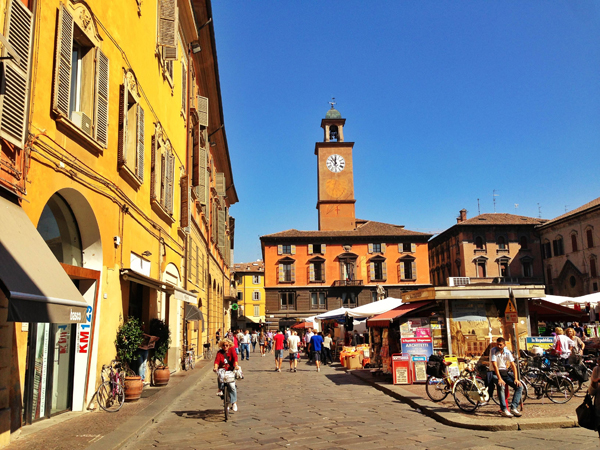 Reggio Emilia
Reggio Emilia
Located north of Modena on Via Emilia, the quiet antique REGGIO EMILIA is a completely different city, where it is worth to rest for a while. There are not many monuments here, but it's nice to walk around the city, and you can also set up a base in the Reggian Apennines.
Some practical information
Reggio is on the main railway line from Bologna to Milan. The train station is in Piazza Marconi 1, the bus station is on via Raimondo Franchetti. EPT office (codz. 9.30-12.30 i 15.30-18.00) it is in Piazza Prampolini, main town square, and usually there is no problem with finding accommodation: Cairoli przy Piazza XXV Aprile 2 (w 0522/32307) has doubles 29 000 L, in Ariosto on via San Rocco 12 (0522-37320) offers doubles with bathroom after 46000 L. It is worth going here if only for that, to eat at the Scudo d'Italia restaurant (close. sb. i nd.), a locally renowned hotel and venue, where you can order an excellent and relatively cheap meal. The dark purple Lambrusco served here is specially bottled in the local azienda and differs from the typical, carbonized versions of this drink. Inside the room, where you can eat well, is a restaurant specializing in sea and vegetable dishes on via Broletto and the noisy Condor, at the lower end of via Spallanzani, where the pizza is served. For bankrupts, there is a mensa in Gioberti a few steps further, in the square of the same name (12.00-14.40 i 18.30-20.30).
City
Reggio is built around two central squares, Piazza Prampolini i Piazza San Prospero, separated by the Duomo and Palazzo del Municipio with fish-tail battlements. As in other cities in the region, the center is closed to traffic and bicycles will knock on cobblestones from all directions. Piazza San Prospero comes alive on market days (wt. i pt.), when a huge selection of fruit is sold from stalls and shops, vegetables, salami in the evening, including the local parmigia-no-reggiano. The buildings in the square are so crowded around the Church of San Prospero, that he seems to be losing his balance and is leaning to one side. It was built in the sixteenth century, the facade is decorated with columns and statues in the niches, guarded by six lions of pink Verona marble, and contrasts sharply with the unornamented octagonal campanile next to it. Via Broletto prowadzi do Piazza Prampolini, overlooking one face of the Duomo, sheltering under a green net and scaffolding for the duration of renovation. Under the. marble, you can see the Romanesque facade of the cathedral, with statues of Adam and Eve above the medieval portal; apart from that, only the apse and the huge crypt have survived from the original building. Inside is a painting of the Assumption Guercina and many tombs, m.in. inventors of the hourglass, Cherubina Sforzani.
At right angles to the duomo stands the frosted-pink Palazzo del Capitano del Popolo. Here the tricolor was proclaimed as the official national flag of Italy, when in 1797 r. Napoleon's Padua Republic was created. Going north from here, you come to the Musei Civici in via Spallanzani, na skraju Victory Square, housing private, gathered in the 18th century, collections of archaeological finds, fossils and paintings (pn.-pt. 9.30-12.30). Galleria Parmeggiani is at the corner of the square, which would also be worth a look, but it has been closed for ten years and it is unknown, when the renovation is over. It is said that there are both important collections of Spanish art, Flemish and Italian, as well as costumes and linen. If it proves still unavailable, it is worth going to the church of Madonna della Ghiara, built in the 17th century. and decorated with frescoes from the Bologna School, depicting scenes from the Old Testament and Guercin's Crucifixion.